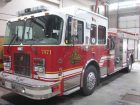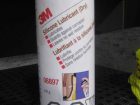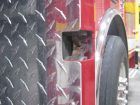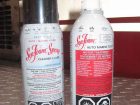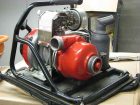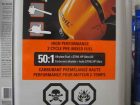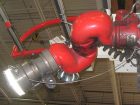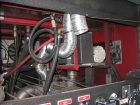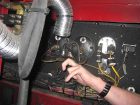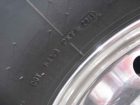
Equipment
Truck Tech: May 2016
The snow is gone. Spring is here. The wash bucket moves from inside the fire station to outside on the apron. That shiny fire truck, which for months has known only road salt, brine and sand, will now be washed, waxed and left to dry in the sunshine. The following are tips and tricks to keep in mind when spring cleaning the rigs.
April 22, 2016
By Chris Dennis
 Photo 1: Spring clean the rigs to remove salt from compartments and electrical components. Use a brine-eliminator wash to neutralize the salt and prevent the metal from continuing to wear away. Chief mechanical officer Chris Dennis has tips and tricks to keep in mind when spring cleaning the rigs.
Photo 1: Spring clean the rigs to remove salt from compartments and electrical components. Use a brine-eliminator wash to neutralize the salt and prevent the metal from continuing to wear away. Chief mechanical officer Chris Dennis has tips and tricks to keep in mind when spring cleaning the rigs.Start by stripping out the truck compartments – wash them down and air them out. A salt brine-eliminator wash will neutralize the salt inside compartments to prevent the metal from continuing to wear away. Use care when spraying water around electrical switches, harnesses, outlets and so on. Once completely dry, it’s a good idea to add a moisture and odour neutralizer to help prevent mold after you repack the compartment.
Next, clean the channels of roll-up doors and then apply a dry silicone-based spray (see photo 2), which prevents dirt from sticking and allows the doors to operate more smoothly. If the apparatus has swing doors or barn-style doors, clean out all locks and handle assemblies of dirt, brine and sand. Use mild liquid detergent, such as Sunlight soap, with built-in degreasers to properly clean out lock and latch assemblies (see photo 3), which are a little more forgiving when it comes to using wet lubricants. Liberally lubricate these assemblies and hinges.
Make sure the door latch mechanisms are all working correctly by opening and closing the doors a few times. Pull on the door handle to make sure the door has latched. If the fire truck is equipped with a door-ajar warning system, make sure it too is working; this may require a helper to sit in the cab and observe a door-warning light or buzzer operation. Remember, the switch can fail closed. When a flashing light or buzzer comes on to tell you something is not closed or stowed away, go check the source; it may be a simple fix. Re-check by opening the compartment in question and if the light or buzzer does not come on, it means the door could be left open, or equipment such as an elevated scene light is deployed.
Nothing beats a full walk-around visual inspection before pulling away from the station. Even if you did a post-trip inspection of the truck when you came back from the last call, another firefighter doing a truck familiarization may have left a door open or a pullout tray extended; and if that particular area of the truck had a defective switch, the warning system would be ineffective. Driving the truck out of the fire station with a door still open or equipment still deployed could easily damage the fire station bay door, the truck, or, worse yet, harm a person.
A vehicle system monitor that tells you which door is open should also show you when doors are closed. These warning systems are usually wired to activate once the parking brake is released if a door or piece of equipment still deployed (ladder rack, hose bed doors, aerial stabilizer and so on). Always chock truck wheels for added safety.
Next, pay attention to the truck’s four-stroke and two-stroke operated gas engines. If the engine is four-stroke, change the spark plug, engine oil and gasoline and check the air filter. Excessive choke operations in colder weather can cause engine flooding and gasoline contamination in the engine oil. The first sign of flooding is higher-than-normal engine oil level, as well the oil that is very thin or fuel that is contaminated. Flooding prevents the essential lubrication of engine parts and reduces engine life considerably. Spark plugs can also become fuel fowled, which will make the engine harder to start. Drain out the fuel tanks from all engines, including small power tools or equipment. Be sure the factory recommended fuels are used as well as stabilizers. Insider tip: Sea Foam (see photo 4) is a quality product that will lubricate as well as help to stabilize fuel and jack octane. Air filters – foam, paper or cardboard – can absorb raw fuel like a sponge and will hinder air intake and make it difficult or for the engine to start. Spend a little time and a little cash now to clean up the engine and prevent expensive failures (see photo 5).
A two-stroke engine requires the same tender loving care, however, there is no crank-case oil to change. Just dump the premixed fuel from the machines, truck tank and gas cans and replace with fresh premix. Again, be sure to follow the manufacturer-recommended oil and fuel mixes. Another insider tip: try premixed fuel in a can, such as TruFuel or Motomix, sold by dealers or found at most local big box hardware stores (see photo 6). An unopened premix has years of shelf life. Vaughan Fire and Rescue has been using premixed products in all our two-stroke tools without incident for more than a year. (See the May 2015 Truck Tech column for a description of premixed products and the advantages they have over gasoline and fuel mixes.) Keep the premixes in approved containers or decentered into plastic gas cans.
Early spring is also a good opportunity to address aerial maintenance. Take time to degrease and lubricate the aerial and fly sections, booms, and so on, as per manufacturers’ recommendations (see photo 7). Brine and road dirt stick to aerial and tip equipment and monitors and can destroy wiring circuit boards, bearings and bushings. The brine will leach into all aerial sections and eat away at the equipment over time. Prevent further damage to the truck by washing all parts with liquid soap and water. Take extra care when cleaning the aerial if your department service area includes dirt roads. Dirt acts like sand paper, etching into sliders, cables, sheaves and hydraulics. Deep cleaning the aerial also gives crews an opportunity to see up close the parts of the apparatus and how they work. We have found over the years at Vaughan Fire that when operation firefighters help with aerial maintenance and cleaning, they have a better understanding of the equipment.
If your rigs are equipped with pump-house winter enclosures, spring is the time to open them up and clean out the brine and dirt. Remove any heat pans to increase air flow in the warm summer months, but be sure to mark them with truck unit numbers so they can be easily replaced in the fall. Next, shut off the pump-house heater. I suggest you verify the blowers are working properly before the cold weather comes back. You may want to look into whether or not your truck has a Canadian cold-weather package – a fabricated area under the pump house area that helps to hold in heat. The heat source for the package can come from a number of places; we use the exhaust system as it usually runs alongside of the fire pump. Newer rigs may be equipped with a diesel-particulate filter (DPF) and/or a selective catalytic reduction system (SCR), both of which generate extreme heat and can be used to keep the pump house area warm as well. Auxiliary heaters, or heaters mounted in the compartment and connected to the truck’s engine cooling system, are the main means by which the fire-pump valve areas are heated, and are usually found on top of the fire-pump module. We have attached additional vent ducting to these heaters to direct the heat to areas that are harder to heat (see photo 8). Today’s electronic pressure governor (EPG) transducers are small (see photo 9) and, depending on the fire-truck builder, may be exposed to extreme cold. Prevent EPG water control issues caused by frozen transducers by using ducting to direct heat from the pump-house heater.
Remove any ground ladders on the sides of the trucks or in the body and inspect them completely. I recommend monthly or weekly truck checks include the ground ladders so that crews regularly clean them and inspect the heat validation stickers and inspection dates. NFPA recommends yearly ground-ladder testing. Ladders with hemp halyards hold water and may have evident mold growth; pay close attention to the areas where the halyards go around pulleys. Check all moving parts as well as locks, rope or cable halyards, beams and rungs. Be sure that the washed ladders are dry before they are put away.
Spring is also usually a good time of year to off-load hose beds. The reason we clean out hose beds and re-flake all the hose is to give the equipment a chance to dry out from winter ops. Use this opportunity to test the hose as well, following testing requirements.
Check nozzles, bale handles, if equipped, and all adjustments. Nozzles in the preconnect load that sit in back of the truck and have not been touched all winter were probably, at some point, covered in snow and de-icing agent. Use soap and water to clean the equipment and allow it to dry before repacking.
■ Inspect tires and rims
Winter roads bring out the bad and the ugly in tires; potholes, built-up ice mounds, heaved curbs and frozen dirt roads all contribute to early tire wear or failure. A couple of good potholes are enough to change alignment angles and cause early tire wear. I recommend a front-end alignment be done every spring, which costs between $350 and $900 per tire.
Tires tend to leak air more often in the colder months due to less elasticity. When the tire compounds harden and are not as flexible, the sealing area between the tire bead and the rim bead can be damaged. Aluminum rims help to dissipate heat when braking and they are lightweight, but they also corrode and oxidize when they come into contact with water and salt or other road-deicing agents. The valve-stem area will also corrode on tires. Lightly spray a soap solution around the rim to tire bead or contact area and around the valve stem to rim area to check for leaks. Fill a portion of the stem with water and look for bubbles, indicating air leaks. Be sure tire pressures are reset for the warmer months according to the manufacturers’ recommendations based on loads.
Tires made by a reputable manufacturer – Michelin, Goodyear, Hankook, Bridgestone – are branded with a United States Department of Transportation (DOT) number close to the tire and rim-bead area. This number is a safety code that confirms the tire complies with all DOT and Transport Canada safety standards. The numbers and letters leading up to the last four characters are for plant location, tire size, model of tire and manufacturer; the last four characters are the week and year, respectively, the tire was manufactured.
Example of a DOT number: 9BYJ******1604 (16th week of 2004) = 12 years old. (See photo 10.)
Every province has a different set of safety standards for vehicle safety inspections, but the average recommendation for tire lifespan is seven years. Vaughan Fire and Rescue Services’ trucks have new tires put on every two to three years, depending on the style of apparatus. Some fire departments, particularly volunteer, may have trucks that do not see many road miles. Our neighbouring department’s volunteer station has trucks with tires that are in amazing condition but have been on the truck since it was purchased 12 years ago. That station’s call volume is low and the runs are short with significant PTO (power take off) or fire pump time – engine is running but no mileage is accrued.
Tires do dry out if they are not frequently used. The first sign of drying tires is cracking in the tread grooves or on the side walls. Sometimes a tire becomes very noisy; this is caused by thick treads that dry and deform in the shape of a small soup dish. These cups in the tread blocks catch air and when they hit the pavement the air is audibly squeezed out of the bowl area.
Follow manufacturers’ recommendations for the maintenance of new tires. One of these recommendations is regular tire rotations. Don’t hesitate to rotate, cross or switch tires from one axle to the next if it is recommended. If rear tires have bud wheels or aluminum rims on the outside drives, ensure the inner drive material is the same before you call in a tire guy to rotate them; if the inner drive material is steel you will have to dismount the tire from the rim. If the tires have never been rotated, the aluminum may be in poor shape on the inside set of drives. A full set of tires can be very expensive. A tandem aerial’s tires can cost in excess of $8,000.
The last items on the spring cleaning to-do list are the tire rims and the fasteners that hold them on. Inspect the rims, front and back sides, all the way around. If the rims are steel, check for excessive rust and flaking and replace if necessary. If the fasteners or wheel nuts holding that wheel on are also in poor shape, replace them as well and be sure they are all torqued back on the truck and re-torqued after 100 kilometres. Keep in mind United States inspections are different than Canadian.
With spring in the air, be safe, be healthy and remember, my friends, rubber side down.
Chris Dennis is the chief mechanical officer for Vaughan Fire & Rescue Services in Ontario. He can be reached at Chris.Dennis@vaughan.ca
Print this page
